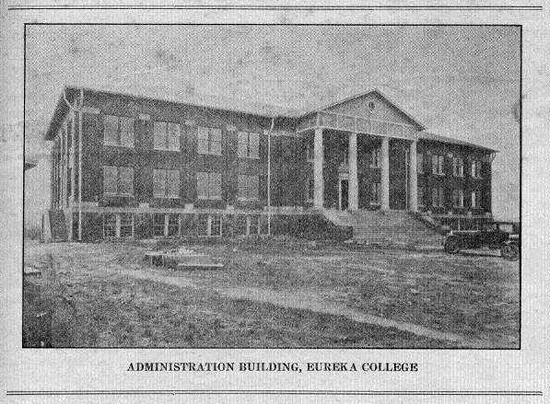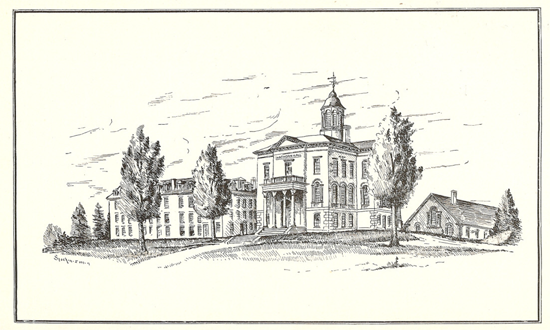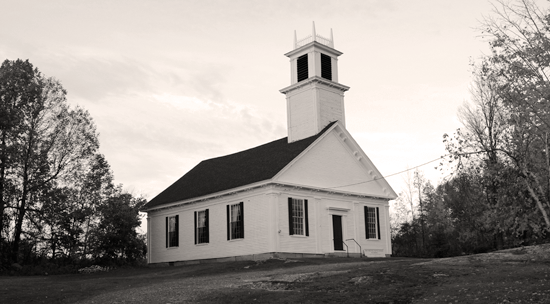As you journey through Free Will Baptist history, you find some intriguing stops along the way. Enjoy exploring the following locations of significance to the Free Will Baptist movement.
- Ayden, North Carolina, originally located on Lee St. in 1898, Ayden Seminary (also known as Free Will Baptist Theological Seminary) was the first attempt by North Carolina Free Will Baptists to establish an educational institution. Their efforts were blessed, judging by the number of students who signed up in 1905. Total enrollment was 133. Thomas E. Peden, a defector from the increasingly ecumenical northern Free Will Baptist ranks (who was himself from southern Ohio), headed the school until 1910. The college was renamed Eureka College (pictured below) with a printing agency known as The Free Will Baptist Press.

- Blakely, Georgia, from 1929, when Eureka College in Ayden, North Carolina closed, until 1941, when Free Will Baptist College first opened its doors, the denomination was without an educational institution. Even Tecumseh College, serving western Free Will Baptists, burned in 1927. Into that educational void stepped Zion Bible School. It was founded in 1935 by Thomas B. (“T.B.”) Mellette, native of Turbeville, South Carolina, and graduate of Duke University.
- Cairo, Illinois, This was the northern terminus for the famed “Underground Railroad,” which helped slaves escape to the north. They would sleep in hiding during the day, traveling only at night until they crossed the Mason-Dixon Line to freedom. Northern Free Will Baptists established Manning Bible Institute to evangelize these former slaves.
- Chester, Ohio (east of Cleveland in Geauga County). This Free Will Baptist School, Geauga Seminary, was begun in 1844. One of its students who came in 1850 was James A. Garfield (U.S. President 1880-81), educated and converted while here. His wife was also a student here (see William M. Thayer’s 1885 book entitled, From Log Cabin to the White House, Life of James A. Garfield, Boyhood, Manhood, Assassination, Death, and Funeral).
- Greeneville, Tennessee. According to Paul Woolsey’s book, Woolsey College began operations in 1873, with aid of a $300 pledge from the northern-based General Conference of Free Will Baptists. NOTE: Just to the east was the Unicoi School which was lost in the northern merger in 1910.
- Harper’s Ferry, West Virginia. This beautiful setting in the Shenandoah Valley is the site of the historically famous “John Brown’s Raid.” It is also where Free Will Baptists established Storer College (pictured below) after the Civil War for the education of the Freedmen. It is now a Historical Park. The main building on campus has been renamed Mather Training Institute and is the training center for the National Park Service. Also of interest is the Curtis (named after Silas Curtis) Memorial FWB Church built on the campus in the late 1800’s and now used as a chapel. Storer continued operations as a black college until 1955.

- Hillsdale, Michigan (about 60 miles southwest of Detroit). Hillsdale was the first Free Will Baptist College in the denomination, begun in 1844, still in operation. Hillsdale College has long been known as a conservative institution, frequently inviting speakers who are politicians of national prominence.
- Keuka, New York (in the Finger Lake region of upstate New York). This is the site where Dr. George H. Ball founded Keuka College in 1890. The Ball family was wealthy because of the success of their canning jar business. Keuka College has been an educational institution for women since 1920 and continues in operation today.
- Kinston, North Carolina. Kinston College was the educational arm of the United American Free Will Baptists during much of the first hall of the twentieth century. Along with Storer College in Harper’s Ferry, West Virginia, Kinston College closed on the eve of the Civil Rights Movement.
- Lewiston, Maine. This is the site of Bates College (pictured below), which was founded in 1854 and is still in operation. Also located here was Cobb Divinity School which continued until 1907. Among the more recognizable recent graduates are Bryant Gumbel and Jane Pauley. Bates College has long been known for its skillful debate teams. Alfred Williams Anthony, the chief architect of the merger, was a long-time professor here, and seems to have been skillful in debating his opponents at the various Quarterly and Yearly Meetings where the proposed merger was discussed.

- New Durham, New Hampshire. This is the site of the oldest standing Free Will Baptist church building in America. The First Church (pictured below), or “Ridge Church” as it is sometimes called, was established by Benjamin Randall in 1780. This was the site of the Centennial Conference in 1880. Also of interest nearby is Randall’s graveyard and the “Boody House” originally owned by Deacon Joseph Boody, where the congregation first met to organize the church.

- Oberlin, Ohio. This is where the early nineteenth century lawyer-evangelist Charles G. Finney lived. He was a professor for most of his life at Oberlin College. Indicating a historical tie between the famous evangelist and a rather famous Free Will Baptist evangelist names David Marks is the fact that Marks is buried on the campus of Oberlin College. A woodcut picture depicting his grave is shown on page 511 of his Memoirs, Second Edition, published in 1847 by his wife Marilla Marks. It reads in part:“The Grave of David Marks, Minister of the Gospel in Free-Will Baptist Denomination, who died Dec. 1, 1845, aged 40 years and 26 days. He commenced preaching at the age of 15 years, and through life was distinguished for his abundant and faithful labors.”
- Old Orchard, Maine. This was the site of Ocean Park, a summer vacation and retirement village for Free Will Baptists. It was located just twelve miles west of Portland, on the main line of Boston and Maine Railroad. Plans for its formation were discussed at the Centennial Meeting of the General Conference in 1880. It was incorporated the next year, after the $6500 purchase of 70 acres that included a section of Old Orchard Beach. By 1889, Ocean Park had grown from nothing to include no less than thirty buildings. Commercial buildings included a store, a restaurant, a half-dozen boarding houses and hotels (some names: Billow House, the Park House, and Granite State), an office of the Morning Star, and a railway station. There was a 2,000-seat Temple, a Tabernacle, and a Chapel.
- Parsonsfield, Maine. This was the site of the first Free Will Baptist School in the United States. It was in operation from 1834 until 1949, when it merged with the public school system of the city. It was founded by John Buzzell who was successor to and biographer of Benjamin Randall. He made Parsonsfield his home for 65 years, from 1798 unti his death in 1863 at age 96.
- Pawnee City, Nebraska, and Tecumseh, Oklahoma. These cities were the sites of two schools established by John H. Wolfe, graduate of Hillsdale College who also defected from the northern Freewill Baptists during their movement toward merger with the Northern Baptists. The two schools were Freewill Baptist Biblical Correspondence School and Tecumseh College.
- Portsmouth, New Hampshire. Birthplace of Benjamin Randall, 1749-1808, who established the Northern Free Will Baptist denomination.
- Rio Grande, Ohio (located in southeastern Ohio). Rio Grande College was started with funds provided by a Free Will Baptist lay couple whose names were Nehemiah and Permelia Atwood. In the mid-1800’s, they operated a stagecoach inn. A Free Will Baptist minister whose name was Ira Z. Hanning arrived one day by coach. The Atwoods were converted, and a lifelong friendship ensued. Mr. Atwood felt a strong ministerial calling, but felt himself too old. Brother Hanning suggested perhaps God would have him provide a college for the training of young men for the ministry. The college opened in time to celebrate the Centennial observance of our nation’s birth in 1876.

